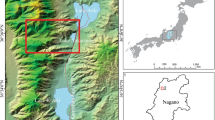Abstract
Concentrations of iron sulphide minerals in sediments within and adjacent to a small intertidal thermal pool near Talasea township are forming and being modified under a wide range of exhalative-sedimentary conditions. A geochemical, mineralogical and bacteriological investigation of these iron sulphides has defined the major reactions leading to their formation and indicated aspects in which their mineralogies, textures and mechanisms of formation differ significantly from those of iron sulphides formed under “normal” sedimentary conditions. The main features of the thermal pool environment are: 1. the occurrence of relatively high iron sulphide concentrations; 2. the preservation, by the strongly anaerobic thermal spring waters, of hydrotroilite formed in the thermal pool sediments in the presence of excess sulphide; 3. the presence in the pool banks of major marcasite (which appears to replace its dimorph pyrite) formed as a result of the development of strongly acidic conditions; 4. the abundance in the pool banks of large euhedral crystals of pyrite and marcasite, and the scarcity of framboids; 5. the presence of sulphate-reducing bacteria in the thermal waters and sediments.
Similar content being viewed by others
References
Bartlett, J. K., Skoog, D. A.: Colorimetric determination of elemental sulphur in hydrocarbons. Anal. Chem. 26, 1008 (1954)
Berner, R. A.: Distribution and diagenesis of sulphur in some sediments from the Gulf of California; Marine Geol. 1, 117–140 (1964)
— Thermodynamic stability of sedimentary iron sulphides. Am. J. Sci. 265, 773–785 (1967)
— Sedimentary pyrite formation. Am. J. Sci. 268, 1–23 (1970a)
— Pleistocene sea levels possibly indicated by buried black sediments in the Black Sea. Nature 227, 700 (1970b)
Bischoff, J. L.: Red Sea geothermal brine deposits: their mineralogy, chemistry, and genesis. In: Degens, E. T., Ross, D. A. (eds.), Hot brines and recent heavy metal deposits in the Red Sea. p. 368–401. Berlin-Heidelberg-New York: Springer 1969
Degens, E. T., Ross, D. A. (ed.): Hot brines and recent heavy metal deposits in the Red Sea. p. 600. Berlin-Heidelberg-New York: Springer 1969
Ferguson, J., Lambert, I. B.: Volcanic exhalations and metal enrichments at Matupi Harbour, New Britain, P. N. G. Econ. Geol. 67, 25–37 (1972)
Fisher, N. H.: Report on the volcanoes of the territory of New Guinea. Territory of New Guinea, Geol. Bulletin No. 2 (1939)
Friedman, G. M., Gavish, E.: Chemical changes in interstitial waters from sediments of lagoonal, deltaic, river, estuarine, and saltwater marsh and cave environments. J. Sediment. Petrol. 40, 930–953 (1970)
Goldberg, E. D.: The oceans as a chemical system. New York: The Sea, Interscience 1963
Heming, R. F., Smith, I. E.: Notes on the thermal fields of Talasea, Pangalu, and Kasiloli, New Britain, TPNG. Bureau of Mineral Resources, Unpublished Record No. 1969/115 (1969)
Koltoff, I. M., Elving, P. J.: Treatise on analytical chemistry, Interscience Pub. 7, 109 (1961)
Lowder, G. G., Carmichael, I. S. E.: The volcanoes and caldera of Talasea, New Britain: Geology and petrology. Bull. Geol. Soc. Am. 81, 17–38 (1970)
Norrish, K., Chsppell, B. W.: X-ray fluorescence spectrography. In: Zussman, J. (ed.), Physical methods in determinate mineralogy. p. 514 London: Academic Press 1967
Reynolds, M. A.: An examination of thermal areas at Garua Harbour, New Britain, August 1954. Bureau of Mineral Resources, Unpublished Record No. 1954/59, (1954)
Rickard, D. T.: The chemistry of iron sulphide formation at low temperatures. Stockholm Contr. Geol. 20, 67–95 (1969)
Roberts, W. M. B., Walker, A. L., Buchanan, A. S.: The chemistry of pyrite formation in aqueous solution and its relation to the depositional environment. Mineral. Deposita (Berl.) 4, 18–29 (1969)
Stephens, J. D., Wittkopp, R. W.: Microscopic and electron beam microprobe study of sulphide minerals in Red Sea mud samples. In: Degens, E. T., Ross, D. A. (eds.), Hot brines and recent heavy metal deposits in the Red Sea, p. 441–447. Berlin-Heidelberg-New York: Springer 1969
Trudinger, P. A., Lambert, I. B., Skyring, G. W.: Biogenic sulphide ores: a feasibility study. Econ. Geol. 67, 1114–1127 (1972)
Truper, H. G.: Bacterial sulphate reduction in the Red Sea hot brines. In: Degens, E. T. Ross, D. A. (eds.) Hot brines and recent heavy metal deposits in the Red Sea, p. 263–271. Berlin-Heidelberg-New York: Springer 1969
White, D. E.: Thermal waters of volcanic origin. Bull. Geol. Soc. Am. 68, 1637–1658 (1957)
-- Hem, J. D., Waring, G. A.: Chemical composition of subsurface waters. In: Data of Geochemistry, U. S. Geol. Survey, Prof. Paper 440-F, p. F1–F67 (1963)
Author information
Authors and Affiliations
Additional information
Exhalative-sedimentary environments are defined here as sedimentary basins which are influenced by thermal springs and vapours.
Bureau of Mineral Resources, Geology and Geophysics. Published with the permission of the Director.
Division of Mineralogy, C.S.I.R.O.
Rights and permissions
About this article
Cite this article
Ferguson, J., Lambert, I.B. & Jones, H.E. Iron sulphide formation in an exhalative-sedimentary environment, Talasea, New Britain, P.N.G.. Mineral. Deposita 9, 33–47 (1974). https://doi.org/10.1007/BF00203276
Received:
Issue Date:
DOI: https://doi.org/10.1007/BF00203276




